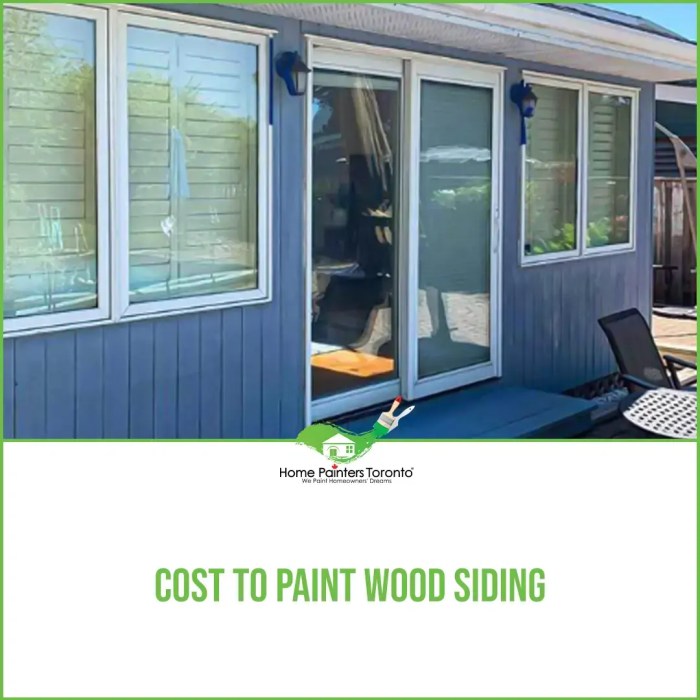Exploring the Cost of Painting Wood Siding: A Complete Guide

Embark on a journey through the intricacies of painting wood siding cost, where we unravel the key factors and steps involved in this process. Discover how to enhance the aesthetic appeal of your home while staying within budget constraints.
Delve into the realm of painting wood siding cost and uncover the secrets to achieving a flawless finish that stands the test of time.
Cost Factors for Painting Wood Siding
When considering the cost of painting wood siding, there are several factors that can influence the overall expense of the project. From materials and tools to the size and condition of the wood siding, each element plays a crucial role in determining the final cost.
Materials and Tools Needed
- High-quality paint: Using premium paint can result in a more expensive upfront cost but may require fewer coats and provide better durability in the long run.
- Primer: A good primer helps the paint adhere better to the wood surface, ensuring a longer-lasting finish.
- Brushes, rollers, and other painting tools: Investing in quality painting tools can make the job easier and more efficient, but these items can contribute to the overall cost.
Size and Condition of the Wood Siding
- Square footage: The larger the surface area to be painted, the more paint and materials will be required, increasing the overall cost.
- Preparation work: If the wood siding is in poor condition and requires extensive cleaning, repairs, or sanding before painting, the labor costs can add up significantly.
- Number of coats: Depending on the color and type of paint used, multiple coats may be necessary to achieve the desired finish, impacting both material and labor costs.
Preparation Steps Before Painting
Before painting wood siding, it is crucial to properly prepare the surface to ensure a smooth and long-lasting finish. This includes cleaning, sanding, priming, and inspecting for any necessary repairs.
Cleaning the Wood Surface
- Start by cleaning the wood siding thoroughly to remove dirt, dust, mildew, and any other debris that may affect the paint adhesion.
- Use a mixture of water and mild detergent or a specialized wood cleaner to wash the surface, and rinse it well to ensure no residue is left behind.
- Allow the wood siding to dry completely before proceeding to the next steps.
Sanding the Wood Surface
- After cleaning, sand the wood siding to create a smooth and uniform surface for the paint to adhere to.
- Use sandpaper with a medium grit to sand away any rough patches, imperfections, or old paint that may be peeling.
- Make sure to sand along the grain of the wood to avoid causing any damage to the surface.
Priming the Wood Surface
- Apply a coat of primer to the wood siding to seal the surface, improve paint adhesion, and enhance the durability of the finish.
- Choose a high-quality exterior primer specifically designed for wood surfaces to ensure optimal results.
- Allow the primer to dry completely before moving on to the painting stage.
Inspecting for Damage or Repairs
- Inspect the wood siding for any signs of damage, rot, or decay that may need to be addressed before painting.
- Repair any cracks, holes, or damaged areas using wood filler, caulk, or replacement boards as needed.
- Ensure that the wood siding is structurally sound and in good condition before proceeding with the painting process.
Types of Paint for Wood Siding
When painting wood siding, choosing the right type of paint is crucial for a successful and long-lasting finish. There are various options available, each with its own advantages and considerations.
Oil-Based Paint vs. Latex-Based Paint
Oil-based paint has been a traditional choice for wood siding due to its durability and ability to provide a smooth finish. It is resistant to wear and tear, making it ideal for high-traffic areas. However, oil-based paint tends to yellow over time and emits strong fumes during application.On the other hand, latex-based paint is a more environmentally friendly option that dries quickly and has low odor.
It is also easier to clean up with soap and water. Latex-based paint is flexible, allowing it to expand and contract with the wood, reducing the risk of cracking or peeling. While it may not be as durable as oil-based paint, advancements in technology have made latex-based paints more resilient.
Choosing the Best Paint Finish
When selecting a paint finish for wood siding, consider factors such as the level of sheen and the desired aesthetic. Here are some common paint finishes to choose from:
- Satin:Satin finishes offer a subtle sheen that is easy to clean and provides a smooth appearance. They are ideal for wood siding that requires a bit of gloss without being too shiny.
- Semi-Gloss:This finish has a higher sheen than satin, making it more durable and resistant to moisture. Semi-gloss finishes are suitable for wood siding in high-moisture areas like bathrooms or kitchens.
- Flat:Flat finishes have a matte appearance that can help hide imperfections on the wood siding. While they are not as washable as satin or semi-gloss finishes, flat paints offer a more rustic look.
Painting Techniques and Application
When it comes to painting wood siding, using the right techniques can make a significant difference in the final result. By following recommended methods and applying paint correctly, you can achieve a professional finish that not only enhances the appearance of your home but also protects the wood from the elements.
Recommended Techniques for Painting Wood Siding
- Clean the surface thoroughly before painting to remove dirt, dust, and any previous coatings.
- Use a high-quality primer to ensure proper adhesion of the paint to the wood siding.
- Apply paint in thin, even coats to prevent drips and ensure a smooth finish.
- Work in small sections to maintain a wet edge and avoid visible brush marks.
- Choose the right tools, such as a high-quality brush or roller, to achieve the desired finish.
Process of Applying Paint Evenly and Efficiently
- Start by cutting in the edges and corners with a brush before using a roller for larger areas.
- Apply paint in the direction of the wood grain to enhance the natural look of the siding.
- Avoid overloading the brush or roller with paint to prevent drips and uneven coverage.
- Work quickly but carefully to blend each section seamlessly for a uniform appearance.
- Allow sufficient drying time between coats as recommended by the paint manufacturer.
Tips for Achieving a Professional Finish
- Inspect the siding for any imperfections and make necessary repairs before painting.
- Choose a high-quality paint that is specifically formulated for exterior wood surfaces.
- Protect surrounding areas with painter's tape and drop cloths to prevent accidental spills or splatters.
- Consider applying a second coat of paint for enhanced durability and longevity of the finish.
- Regularly maintain the painted wood siding by cleaning and inspecting for any signs of wear or damage.
Maintenance and Longevity
Proper maintenance is crucial in extending the lifespan of painted wood siding. Regular inspections and touch-ups can prevent minor issues from escalating into major problems, ultimately preserving the integrity of the siding.
Importance of Regular Inspections
- Inspect the painted wood siding annually for signs of wear, peeling, or cracking.
- Address any issues promptly to prevent moisture infiltration and wood rot.
- Check for mold or mildew growth, especially in areas with high humidity.
Tips for Preserving the Painted Finish
- Regularly clean the siding with a mild detergent and water to remove dirt and debris.
- Apply a fresh coat of paint every 5-7 years to maintain the appearance and protection of the wood.
- Consider using a topcoat or sealant to enhance the durability of the paint and protect against UV rays.
Protecting Wood Siding from Environmental Elements
- Trim trees and bushes near the siding to prevent damage from branches and foliage.
- Ensure proper drainage around the foundation to prevent water from pooling near the siding.
- Inspect and repair caulking around windows, doors, and trim to prevent water infiltration.
Last Word

As we conclude our exploration of painting wood siding cost, remember that investing in quality materials and proper maintenance can significantly prolong the lifespan of your paint job. Let your home's exterior radiate beauty and charm with a fresh coat of paint that enhances its allure for years to come.
Expert Answers
What are the key factors that influence the cost of painting wood siding?
The cost of painting wood siding is influenced by factors such as the size of the project, quality of materials used, and any necessary repairs or preparations.
How can I choose the best paint finish for wood siding?
When selecting a paint finish for wood siding, consider factors like durability, weather resistance, and desired aesthetic appeal to make the right choice for your home.
What maintenance practices can help extend the lifespan of painted wood siding?
Regular inspections, touch-ups, and protective coatings can all contribute to prolonging the lifespan of painted wood siding and maintaining its pristine appearance.




